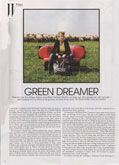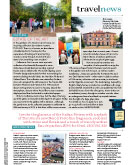A Lesson Learned
A gaggle of women in full-on African dress were utterly perplexed by a moving staircase going up to the stars. One gingerly places a foot on a tread, shrieked and fled.
AFR | August 2011
by Marion Hume
Before reaching air-side at Kenyatta International Airport, I was halted at a security desk manned by those doing something most unusual for their rather serious job; they were giggling. It’s true the scene ahead was, in a purely slapstick sense, rather funny. A gaggle of women in full Africna dress were utterly perplexed by a moving staircase going up to the stars. One gingerly places a foot on a trend, shrieked and fled. Another started slapping the rubber handrail as if it were a snake she must kill to stop it moving-at which point the immigration official who had raised his arm to stamp my exit visa bit into his sleeve to stop himself laughing out loud.
Passport stamped at last, I walked towards the high escalator and stepped on to it to gasps of astonishment. Next, a young girl was behind me, shrieking with glee. “See, it’s OK,” I said, before raising my right leg slowly , indicating how to step off again. While I was running late for the Nairobi-London night flight, I hung around just long enough to see others of the group emerge over the top from what. by the look on their delighted faces, has been the ride of their lives.
We all travel so much these days, it’s a struggle to remember our own first time. But to travel, to transit your fist airport, to fly, when you come from a country mired in poverty, is an even more extraordinary thing. Of course not even Kenyan is poor- far from it- but my sense was these women were certainly not Nairobi cosmopolitans. By the time they reached the top of the escalator, their eyes were sparkling with both astonishment and a sense of achievement. They’d conquered something and they hadn’t even left the country.
Still, one must always be wary of stereotyping. I recently worked with a Kenyan cameraman who told me how an international director had shown him some footage shot by his foreign team. Seeing a filthy little toddler digging in the mud with a stick, the cameraman suggested it might not be a great idea to use that sequence but was ignored.
Months later, a mother watching her flat screen TV was furious when she spotted her son being used in one of those bulletins urging us to flex out credit cards for charity. “Don’t those people’s kids ever sit in the yard?” she shouted. (That, and demanding to know why, when the images of kids from rich countries are protected, no one though to so much as ask whether a mother might be equally protective of her little boy). The cameraman said he’d heard that parents in New York and London have become so scared, they never let their kids just be kids, sitting in the sun digging for worms.
Wherever my escalator ladies were headed, I hope there are people to guide them through the subtleties of their new location. For while I was only able to teach them the not wildly complicated skill of how to ride an escalator, what they gave me in exchange was more profound.
If we are lucky in our working lives, we are forever fronting up to new experience. Yet sometimes, I know that makes me nervous and now I now realise that the terminology we use is partly to blame. Why would I relish risking going ‘out on the wire’ when I lack the balancing skills of a circus performer? But stepping on to an escalator, going up? I can do that. So from now on, I’m going to remember the Kenyatta escalator ladies when I need reminding that the new isn’t always to be feared. It can be fun.






